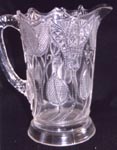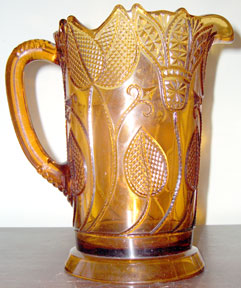 |
Beaded Tulip by Marg Iwen |
| This
pretty pattern was made by the McKee Glass Company, Pittsburgh, about
1894. The original McKee catalog name was ANDES, but Ruth Webb Lee
called it BEADED TULIP, the name most commonly used by collectors
today. The main pattern elements consist of two varieties of coarse flowers on rather erect stems. The ridges that make up the edges of the flowers are notched, not beaded, so why the name Beaded Tulip was chosen remains a mystery. |
 |
| It has been suggested that the designer of the pattern took direction from Pennsylvania Dutch designs. Others feel the inspiration may have come from old stitchings that graced the walls of 19th Century homes. Some forms comprising this pattern have smooth rims, but many have irregular edges of floral "petals." Consequently, these forms are subject to damage which may range from a small hardly noticeable chip to a completely sheared off petal. Because the edges of some pieces are so irregular, damage to them may have occurred when they were removed from the mold--but more than likely damage was inflicted by previous owners. |
 |
Forms
known to exist include: Cake stand Master berry bowl, (may be found with cover) Individual berry or flat sauce Oval relishes in at least three sizes Water pitcher Milk pitcher Pitcher sized between milk pitcher and creamer Goblet Wine Champagne (rare) Wine tray Water tray Covered sugar bowl Creamer Spooner Covered butter Footed sauce (scarce) Possibly other forms exist. |
|
 |


